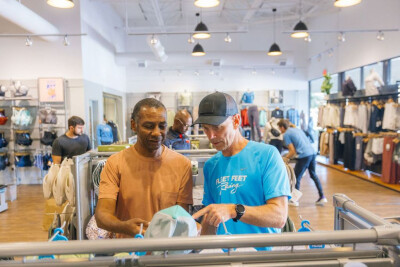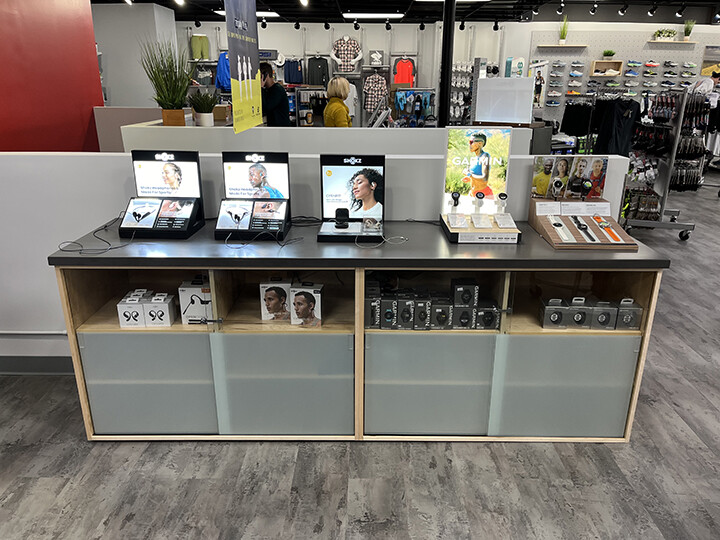Before I broach the topic of how to sell more essentials, I want to first name the three most common reasons why so many of your floor staffers have such a hard time including accessories in the customer’s journey.
First off, and rather ironically, the fitter doesn’t even know these essentials exist. Or, they know they exist but don’t know enough about them to really believe in them. And finally, they think discussing any item beyond what the customer came in for will be seen as an upsell.
Surely there are many more excuses for not moving essentials, but these three, in my 20 years of experience, are the main culprits for essentials being more regularly dusted than rung up.
Boiling It Down
So, before run specialty retailers can ever sell more essentials, they will need to remedy these issues at their root. The solution, dare I say, is simple — it all boils down to education. Floor staff who don’t know about – or don’t believe – in a product are suffering from, above all else, a lack of training. That’s your fault. Your employees aren’t talking about, let alone selling, your amazing inventory because they haven’t been given the proper tools to do so.
As for the third example — staffers who are worried about being perceived as used car salespeople simply need to be reminded about what they’ve been hired to do. Unless your store is the rare example of a sales-above-all retail environment, you likely hired your team members to serve your customers’ myriad needs, which, beyond product, includes emotional, social and informational needs, to name a few.
You also probably ask your staffers to treat every customer like they are the only customer of the day, then lean in and genuinely execute a few things, including: Engage curiosity, actively listen, problem solve, make relevant suggestions and create space to empower the customer to say no at any point along the way. This sort of ideal floor staffer spends the day connecting deeply with every customer, which inevitably reveals more reasons to teach customers about all sorts of other things that are relevant to their story.
This sort of staffer teaches all day long. They have no problem letting the customer decide for themselves whether or not any extras end up in the bag. This sort of staffer doesn’t care about sales outcomes. And yet, their monthly numbers consistently outpace their sales-minded colleagues. Curious, isn’t it?
Staffers who have been thoroughly educated about everything in your store, and who also think of themselves as an expert educator are, without a doubt, your essentials dream team.
Having a foundation of education-minded floor employees is the crucial step one to anything else you may garner from the rest of this article. So, if that’s not yet a consistent reality in your store, go make that happen before building strategies around the next section.
The Next Steps
When you’ve got a team of expert teachers zipping around your store, ready and willing to sling knowledge and possibility at every person who walks in, you’re ready to make the leap to the next level. But take heed: It isn’t easy to balance this educational mindset with your business’s need to analyze numbers, so make sure you do it in a way that proves both customer care and metrics are integral elements of your healthy and thriving enterprise.
Okay, now I’d like you to brace yourself. Because what I am about to suggest is a purposeful disruption of run specialty hegemony.
Currently the majority of the many fit processes in our landscape are designed to address one main thing — the customer’s perceived needs. Someone comes in for shoes — and you sell then shoes. It’s a win-win and everyone’s happy. The same process typically allows a moment to address unperceived needs, too. But it often comes as an afterthought, which decreases its efficacy because, you guessed it, it feels like an upsell.
It often looks like this: A customer comes in for shoes and chooses a pair to buy, but only afterwards is asked if they want to get some socks, too. Or try some insoles or a massage tool. Or they’re asked the dreaded question I encourage you to make illegal in your four walls: “Is there anything else I can get you?” Any of this look familiar?
This, my friends, is how so many specialty fitters do it. Maybe it’s how they’ve always done it. Or perhaps it’s how they’ve evolved the process to make their lives easier. Or maybe it’s how many fitters respond to stress — a long line, antsy customers, a big ticket, etc. There are any number of excuses for not taking responsibility for a thorough outfitting experience with every single customer. And all of your fitters are guilty of, at least occasionally, compromising the customer’s experience.
In a rock solid and comprehensive fit, the customer is best served by you letting them know, far in advance of the last few minutes, that you’ll not only get them those shoes they came in for, but also make relevant suggestions based on their unique story. If they know you plan to talk about something they didn’t visit for, they are more likely to be engaged when that time comes. The importance of finessing the forecast cannot be understated.
I recommend you take a step back and fully rethink your age-old fit process. Does it, in its current iteration, lead to a wholly educated and outfitted customer base? Does it guarantee that every fit will introduce something besides the customer’s known needs? Does it lend to a healthier bottom line? If yes, right on! If no, you need to mess with your process. Allow me to get the wheels turning for you.
I suggest you include these four key components in every fit (without exception):
1. The Customer’s Perceived Needs
2. The Customer’s Unperceived Needs
3. The Customer’s Wants
4. A Wildcard
Let’s take a look at each of these to better understand how they fit into your process.
1. The Customer’s Perceived Needs
This is a lob — the easiest of the four components. Odds are that upon entering, the customer promptly told you what brought them in. It was probably shoes, but it could have been anything. Covering this base is as easy as repeating their words back to them. Your words prove you were listening and create momentum, but this is only the beginning.
HOW IT MIGHT SOUND:
“You’re here for shoes! Fantastic! You’ve come to the right place! Let’s get started.”
2. The Customer’s Unperceived Needs
Unperceived needs are exactly as it sounds — things the customer needs but doesn’t know about. The only way to identify unperceived needs is to understand the customer’s full story. They only way to do this is to conduct an amazing interview. What do they plan to do with the shoes? Is mileage or surfaces a factor? Any particular injuries, past or present? Any specific goals? Anything particularly important about the shoes they’re about to try on?
There are plenty of questions you ask to ascertain the big picture. And once you have all you need, you start using the specific details of their story to name relevant product connections.
HOW IT MIGHT SOUND:
“You told me you’re dealing with some knee pain. Before you leave today, I’d like to show you some knee braces and a couple massage tools that may help you manage your pain. How’s that sound?”
3. The Customer’s Wants
Even a thorough and logical excavation of the customer’s story may keep their wants elusive. Maybe they’ve had their eye on a specific item for reasons unrelated to their particular activity. Maybe there’s something on their radar they are hesitant to bring up. Maybe they want shoes for themselves, but after your amazing fit they now want to buy someone a gift card.
There are a million possible maybes here. Since wants are something only they can tell you, your best bet is to lay those cards on the table and flat out ask them what you missed.
HOW IT MIGHT SOUND:
“I believe I’ve mentioned everything that makes good sense today — but I’m wondering if there’s something else you’d like? What did I miss?”
4. A Wildcard
A wildcard in retail is defined as an unexpected (or less-expected) product option. It can be any number of things — a product or brand that’s new to your store, an item of inventory that you’re trying to turn at a higher rate, or even a quirky thingy you want to randomly share with the customer. It need not be relevant or connected to the customer’s story at all.
So why do you show it? Because you simply don’t want them to leave without seeing it. Sort of like you’re keeping them in the know. In the inner circle.
HOW IT MIGHT SOUND:
“Before we wrap up, there’s a new item we just got in that I’d love to show you. It’s unlike anything we’ve ever had and I’d enjoy hearing your thoughts on it!”
Wrapping Up The Essentials Sale
A soup-to-nuts service experience is rare these days. Customers are used to walking into a retail establishment and having, at best, their perceived needs met. Rarely does a store take time to excavate any unknown possibilities just waiting to be uncovered.
Why do they skip it? Because a strategy like this takes a little extra time. But it’s this little investment in time that will shine a brighter light on your store. It’ll prove to the customer that you genuinely want to help. That they matter.
You’ve already got the raw materials to make this a reality, so why not give it a go? Be advised, however, that developing a culture of knowledgeable, service-driven educators who crush the essentials category won’t happen overnight, so be sure to pace yourself.
Your efforts to make it so are well worth it. Because not only will this team of educators add to your total profit, they will also ensure your customers are able to do their thing successfully and with all the tools they need and want (or at least a basic knowledge of them).
They – your staff and customers – will also feel a deeper connection to you because you took an extra moment to show you care. Education, I assure you, is the secret to staff/customer retention and to a booming business.
When the student feels successful, you are successful. Any teacher will tell you as much. Prioritize that.







